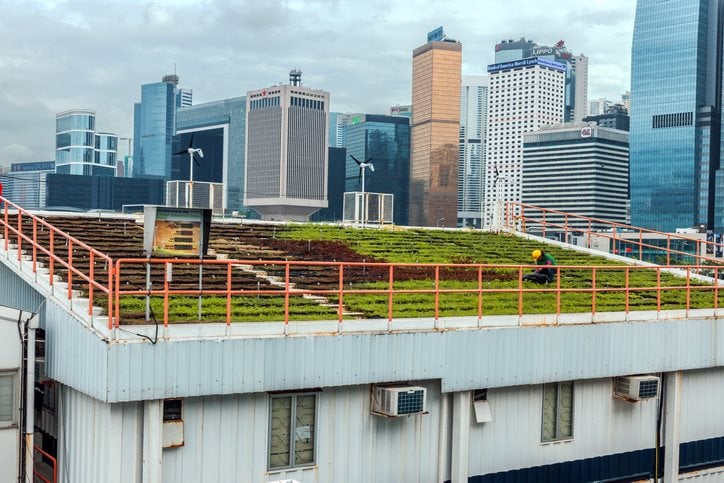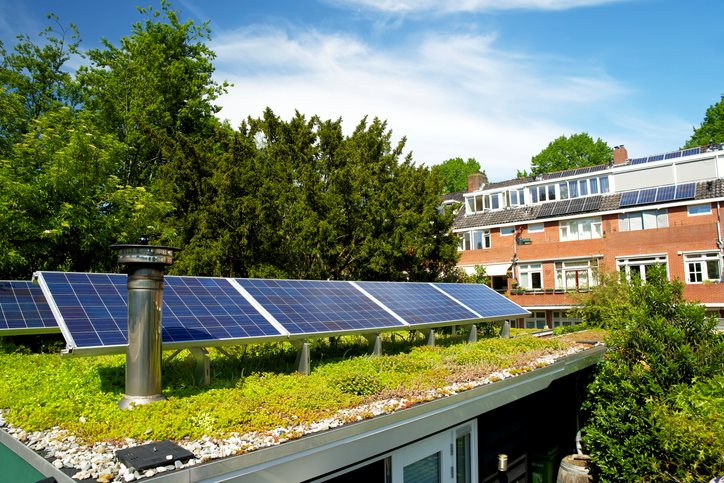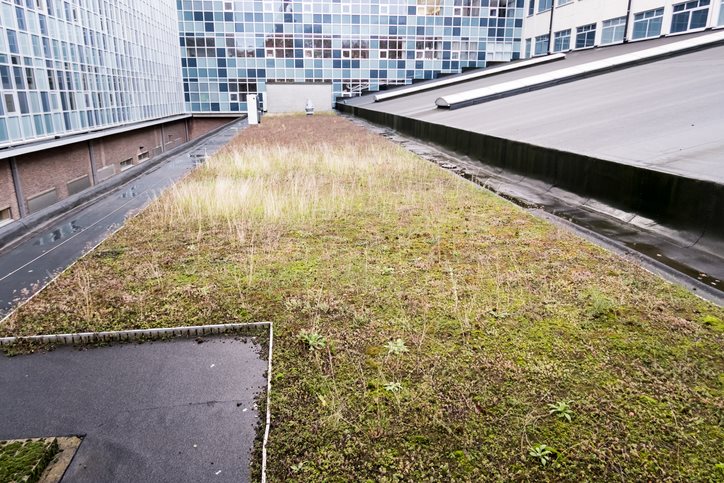Heat is a killer that claims more than 5 million lives every year.
We know that human-caused climate change is making it worse. The Earth has warmed about 1.1 degrees Celsius since the dawn of the Industrial Revolution, and we’re on track to breeze past 1.5. Wildfire seasons have become longer and more destructive. The Western United States is currently in the middle of the worst drought it has experienced in 1,200 years. Global warming has grown so intense in some areas that cities all around the world–from Athens to Los Angeles–are beginning to name heat waves like we name hurricanes. It has been so hot this year that streets have buckled, car windows have shattered, and thousands of cattle have fallen dead where they stood, baking under the sun in triple digit temperatures.
And that was all before summer even began.
Now for the good news: There are a lot of things we can do right now to approach our buildings and our cities with sustainable construction methods in mind. When it comes to beating the heat, one of the most effective tools we have is green roofs. Simply by seeding the tops of our buildings with plant life, we can make our cities cooler, healthier, and more sustainable places to live.
In this article, we will explain what green roofs are, where they come from, and lay out some of the biggest advantages they offer in the fight against climate change. Then we’ll take a quick dive into the weeds by describing how green roofs work. Finally, we’ll showcase a few helpful resources for anyone interested in learning more about green roofs or perhaps building one of their own.
Green Roof Definition: What Is a Green Roof?
A green roof is a layer of vegetation that either partially or completely covers the top of a human-made structure.
Also called living roofs, green roofs are often composed of multiple layers, the most important being the plant life, the growing medium, and a waterproof membrane. For a closer look at the anatomy of a green roof, skip ahead to the “How does a green roof work?” section of this article.
Green roofs serve several functions, including as gardens, aesthetic features, stormwater management systems, and building insulators. We’ll take a deeper dive into the many benefits of green roofs, including how they can be used to combat global warming, in a moment.

Modern green roofs can come in many shapes and sizes, but there are generally two types.
- Extensive green roofs have shallower soil, are less-expensive to install, and are often limited to grasses and succulents in the sedum family.
- Intensive green roofs have deeper soil, are more expensive to install, and can accommodate almost any type of plant life.
| Extensive Green Roof |
Intensive Green Roof |
- Shallow soil.
- Ideal for single/multi-family residences.
- Can only use a narrow range of plants.
- Simpler to install on existing roofs.
- Lightweight.
- Less expensive.
- Lower maintenance.
- Often inaccessible to people.
|
- Deeper soil.
- Ideal for commercial buildings.
- Can use different types of plants, including flowers, grasses, and even trees.
- May include pathways, benches, fountains, and other features.
- Heavier weight requires stronger structure.
- More expensive.
- Higher maintenance.
- Usually accessible to people as green space.
|
What Is the History of Green Roofs?
The seeds of the modern green roof movement first sprouted in Germany, but humans have been using green roofs since ancient times. Some of the earliest examples include the fabled Hanging Gardens of Babylon and the Mesoptamian Ziggurat of Nanna, a fortress-like temple dating back to 600 BC that sported green terraces and a lush rooftop garden.

Pictured above: Gardens of Babylon. Image source: Renewableenergyhub.us
Green roofs ebbed and flowed across cultures and down the centuries, reemerging by accident in the 1880s when a German roofer named H. Koch, hoping to prevent fires, began adding sand and gravel to the highly-flammable tar rooftops of the era. Errant seeds began to naturally grow in the substrate, forming verdant meadows across the industrialized skyline.
Germany continued to play an outsized role in the research and development of green roofs, culminating with the release of the world’s first green roof building guidelines, which are still used in Europe to this day. Having mastered proper waterproofing and irrigation methods, the German green roof market exploded in the 1980s, with more than 1 million square meters of green roofs installed by 1989. By 2019, greenery would cover roughly 120 million square meters of German roof space.
Now, green roofs are common features in many European nations and cities. In North America, green roofs have only recently begun to catch on, though the market is growing fast as the warming effects of climate change have become harder to ignore.
What Are the 10 Main Green Roof Benefits?
Green roofs aren’t without their disadvantages: they can be quite expensive, difficult to maintain, and leaks are sometimes hard to identify.

But if you have the means to install one, we believe you will find that the benefits of green roofs massively outweigh their pitfalls.
- Green roofs reduce heat
- Green roofs absorb carbon dioxide
- Green roofs purify the air
- Green roofs increase energy efficiency
- Green roofs improve stormwater management
- Green roofs are a source of healthy food
- Green roofs improve quality of life
- Green roofs promote biodiversity
- Green roofs prolong the life of rooftops
- Green roofs can save money
Let’s take a closer look.
Green roofs reduce heat
Green roofs are instrumental in the fight against the urban heat island effect.
An urban heat island is what you get when you replace large swaths of nature with high-concentrations of steel, concrete, and asphalt. These common building materials absorb and re-emit an enormous amount of heat, driving temperatures in cities anywhere between 1 to 7 degrees higher than surrounding areas. Ambient heat generated by vehicles and air-conditioning units have further exacerbated the problem. If action isn’t taken, researchers predict that the urban heat island effect will worsen as more of humanity migrates to cities in the decades to come.
The latest IPCC report underscores with “very high confidence” that one of the best things we can do to cool down our ever expanding cities is to install more green roofs.
Green roofs absorb sunlight that would otherwise bake into the building’s roof deck, adding to exterior and interior heat. According to the Environmental Protection Agency, green roofs can lower ambient city temperatures by up to 5 degrees. Meanwhile, by providing shade, the temperature on the green roof itself can be up to 30 to 40 degrees lower than conventional rooftops.
(As a brief aside: Green roofs are just one of many climate strategies that can be deployed in tandem with one another. Some other approaches include green renovation and adaptive reuse, widespread adoption of green building standards, installing more energy efficient HVAC systems, and replacing traditional construction materials with more renewable alternatives.).
Green roofs absorb carbon dioxide
Green roofs can also help us push back against the primary driver of climate change: carbon emissions.
It bears repeating that global warming is caused by human activities that emit large quantities of greenhouse gasses, carbon dioxide being chief among them. Plants, of course, absorb carbon dioxide from the atmosphere, making them one of our most powerful allies in our fight against climate change:
A recent study showed that green roofs can absorb as much as 1.79 kilograms (almost 4 pounds) of CO2 per square meter every year. Put another way: At its current level of green roof coverage (120 million square meters), Germany is able to remove about 240,000 tons of carbon dioxide from the atmosphere every year. That sounds like a lot until you remember that worldwide production of concrete alone spews more than 2 billion tons of carbon into the atmosphere every year.
Still, it’s a good start. And imagine how much of an impact we could make if more roofspace was converted to green space worldwide.
Green roofs purify the air
Let’s not forget: Plants also generate oxygen and clean the air.
City air is notoriously dirty from industrial smog and vehicle exhaust. Short of cutting back on fossil fuels and internal combustion engines, green roofs are an excellent way to boost urban air quality: In a recent white paper on the subject, scientists showed that green roofs can reduce air pollution by as much as 30 to 57%. Meanwhile, about 1.3 kg (roughly 3 pounds) of clean oxygen is created per square meter of green roof every year.
Green roofs increase energy efficiency
The heating and cooling of our buildings is a major contributor to the climate crisis. According to the International Energy Agency, about 20% of the world’s fossil fuel driven energy goes toward air conditioning our buildings.
The insulation provided by green roofs can put a dent in utility bills while also reducing the negative impact that conventional HVAC systems have on the environment: A study published by the National Research Council of Canada showed that an extensive green roof can reduce daily energy use from air conditioners by as much as 75% in the spring and summer months.
Green roofs improve stormwater management
Water pollution as the result of stormwater runoff is a serious problem in cities. Rain that would otherwise get absorbed into the soil runs off of the hard surfaces of roofs and streets into city sewers. This can result in flooding and the pollution of drinking water, as stormwater runoff carries toxins in the form of fertilizers, oil, pesticides, and other harmful chemicals.
Green roofs can help cities with stormwater management by absorbing rainwater before it hits the streets: A 2009 report by the EPA found that green roofs can remove 50% of a roof’s annual rainfall via evapotranspiration and retention. Green roofs can also act as natural filters, helping to clean polluted water before it enters into the city’s water supply.
Green roofs are a source of healthy food
Green roofs can provide fruits and vegetables to urban communities that all too often are cut off from healthy sources of nutrition. Viable green spaces where gardens can grow are a rarity in the concrete and blacktopped expanses of most modern cities. Green roofs open up a space for the creation of urban agriculture and local food systems, allowing people to grow food where they live and thereby reducing their dependence on processed foods shipped in from outside areas.
Green roofs improve quality of life
Humans need to be in nature. A growing body of research has revealed that access to green spaces has a tremendous impact on our mental and emotional wellbeing. Green roofs can scratch this itch, providing aesthetically pleasing and life-enriching natural environments within cities for individuals, friends, families, and communities to gather on rooftops that would otherwise be barren and uninviting.
Green roofs promote biodiversity
The natural world is teeming with delicate ecosystems, all of which require the interplay of many different species of plant and animal life to survive. Cities aren’t the most hospitable places, but research has shown that green roofs can provide a source of food and shelter for all kinds of plant and animal life, from pollinating insects and migratory birds to any kind of flora that will grow within the rooftop soil.
Green roofs prolong the life of rooftops
Green roofs create an added layer between the roof and the elements, decreasing wear-and-tear and increasing its overall life expectancy.
Green roofs boost property value
A report by the Canada Mortgage and Housing Corporation found that green roofs bring a host of benefits that can boost the property value by as much as 11%.
Green roofs can save money
All of the benefits of green roofs add up to money saved in the long run. One study estimated that the stormwater mitigation, improved health benefits, added energy efficiency, and pollution reducing qualities of green roofs alone can save $200,000 over a 40 year lifespan.
How Do Green Roofs Work?
Installing a green roof isn’t as simple as throwing down some sod and calling it a day. Factors like building codes, surface area, the slope of the roof, and the structural strength of the building must all be taken into account.

It’s important to know that green roofs also have multiple layers that perform different functions, though the only absolutely essential layers are the waterproof membrane, the growing medium, and the vegetation.
- Waterproof membrane: Before any other layers are put in place, the roof’s deck must first be coated with a robust waterproof membrane to prevent moisture from leaking into the building. There are many different types of water membrane materials to choose from, though most are a form of durable rubberized sheeting.
- Root barrier: The second layer is the root barrier, a protective waterproof cladding impenetrable by roots that’s designed to protect the underlying waterproof membrane from the elements. Root barriers can be made of a variety of materials, including polyethylene, recycled plastic, and bamboo.
- Drainage layer: The drainage layer directs the flow of excess water off the roof after rainfall. Drainage layers often take the form of permeable plastic plates inlaid with geometric water channels.
- Filter fabric: The filter fabric allows for the flow of water but holds the soil (or the growing medium) in place, preventing silt and other larger particles from running off the roof. Filter fabric is often made of porous plastic fibers.
- Growing medium: The growing medium is the soil, or soil substitute, where the vegetation grows. Growing mediums are often a mix of compost and inorganic matter.
- Vegetation: Of course no green roof would be complete without plant-life. The type of vegetation that can be grown depends on a number of factors, including the surface area of the roof, depth of soil, and climatological conditions such as access to water and sunlight.
Some other optional layers include a leak detection system and a water retention layer to delay the flow of stormwater runoff.
Green Roof Resources
There is a wealth of information online for anyone who’s interested in learning more about green roofs. The following resources are good places to begin furthering your education, whether you’re a layperson interested in novel ways society can fight climate change or a professional builder considering installing a green roof of your own.
- Green Roofs for Healthy Cities (GRHC) is an Ontario,Canada based non-profit whose mission is to increase “awareness of the economic, social, and environmental benefits of green roofs.” The group’s website offers a lot of great information for anyone interested in learning the basics of green roofs.
- The Living Architecture Academy is the educational arm of the GRHC, offering online training courses to individuals interested in learning more about the science and business sides of green roofs.
- The US General Services Administration is a governmental agency that currently maintains roughly 2 million square feet of green roofs on more than 80 federal buildings in the US, all of which can be viewed at a glance on the agency’s green roof tracker. The GSA’s webpage on the subject is a great starting point for anyone looking for green roof research.
- Greenroofs.com offers an interactive visual database that shows an overview of many green roof and other “living architecture” projects that have been completed around the world.
Bottom Line
The hard truth is that the planet is going to keep getting hotter.
The silver lining is that there are plenty of actions we can take right now to adapt to the climbing heat and prevent global warming from cascading into a worst case scenario.
While cities are uniquely vulnerable, decades of research and millions of square feet of rooftop greenery have shown the overwhelming effectiveness of green roofs as a powerful tool in the fight against climate change.